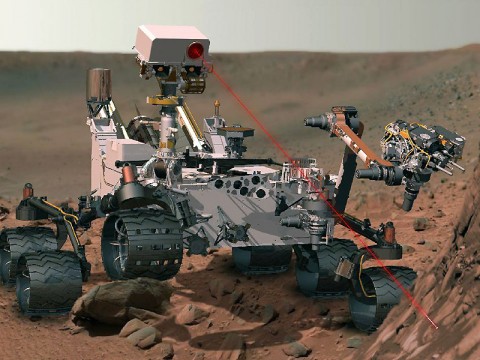Written by Whitney Clavin
Jet Propulsion Laboratory
 Pasadena, CA – NASA’s Mars Science Laboratory is tucked inside its Atlas V rocket, ready for launch on Saturday, November 26th, 2011 from Cape Canaveral Air Force Station in Florida. The November 26th launch window extends from 7:02am to 8:45am PST (10:02am to 11:45am EST). The launch period for the mission extends through December 18th.
Pasadena, CA – NASA’s Mars Science Laboratory is tucked inside its Atlas V rocket, ready for launch on Saturday, November 26th, 2011 from Cape Canaveral Air Force Station in Florida. The November 26th launch window extends from 7:02am to 8:45am PST (10:02am to 11:45am EST). The launch period for the mission extends through December 18th.
The spacecraft, which will arrive at Mars in August 2012, is equipped with the most advanced rover ever to land on another planet. Named Curiosity, the rover will investigate whether the landing region has had environmental conditions favorable for supporting microbial life, and favorable for preserving clues about whether life existed.

If the spacecraft lifts off at the start of the launch window on November 26th, the following milestones are anticipated. Times would vary for other launch times and dates.
Launch
–The rocket’s first-stage common core booster, and the four solid rocket boosters, will ignite before liftoff. Launch, or “T Zero”, actually occurs before the rocket leaves the ground. The four solid rocket boosters jettison at launch plus one minute and 52 seconds.
Fairing Separation
–The nose cone, or fairing, carrying Mars Science Laboratory will open like a clamshell and fall away at about three minutes and 25 seconds after launch. After this, the rocket’s first stage will cut off and then drop into the Atlantic Ocean.
Parking Orbit
–The rocket’s second stage, a Centaur engine, is started for the first time at about four minutes and 38 seconds after launch. After it completes its first burn of about 7 minutes, the rocket will be in a parking orbit around Earth at an altitude that varies from 102 miles (165 kilometers) to 201 miles (324 kilometers). It will remain there from 14 to 30 minutes, depending on the launch date and time. If launch occurs at the beginning of the launch November 26th launch window, this stage will last about 21 minutes.
On the Way to Mars
— The second Centaur burn, continuing for nearly 8 minutes (for a launch at the opening of the Nov. 26 launch window), lofts the spacecraft out of Earth orbit and sends it toward Mars.
Spacecraft Separation
–Mars Science Laboratory will separate from the rocket that boosted it toward Mars at about 44 minutes after launch, if launch occurs at the opening of the November 26th window. Shortly after that, the separated Centaur performs its last task, an avoidance maneuver taking itself out of the spacecraft’s flight path to avoid hitting either the spacecraft or Mars.
Sending a Message of Good Health
–Once the spacecraft is in its cruise stage toward Mars, it can begin communicating with Earth via an antenna station in Canberra, Australia, part of NASA’s Deep Space Network. Engineers expect to hear first contact from the spacecraft at about 55 minutes after launch and assess the spacecraft’s health during the subsequent 30 minutes. The spacecraft will arrive at the Red Planet August 6th, 2012, Universal Time (evening of August 5th, 2012, PDT).
NASA’s Jet Propulsion Laboratory, Pasadena, CA, a division of the California Institute of Technology, manages the Mars Science Laboratory mission. Launch management is the responsibility of NASA’s Launch Services Program at the Kennedy Space Center in Florida. The Atlas V launch service is provided by United Launch Alliance, Denver.


